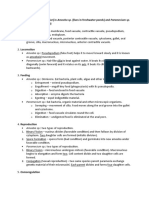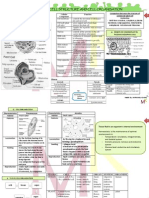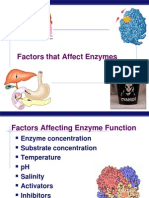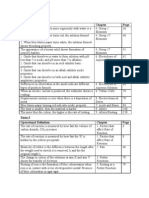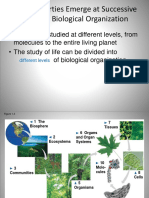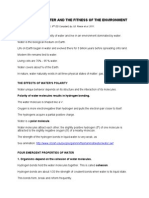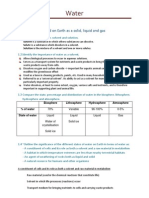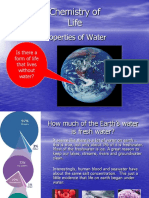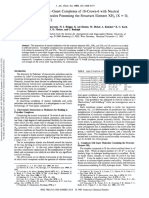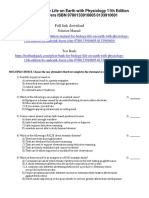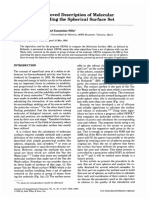Molecules of Life: 1.1 A) Explain The Structure of Water Molecule
Molecules of Life: 1.1 A) Explain The Structure of Water Molecule
Uploaded by
khanny96Copyright:
Available Formats
Molecules of Life: 1.1 A) Explain The Structure of Water Molecule
Molecules of Life: 1.1 A) Explain The Structure of Water Molecule
Uploaded by
khanny96Original Description:
Original Title
Copyright
Available Formats
Share this document
Did you find this document useful?
Is this content inappropriate?
Copyright:
Available Formats
Molecules of Life: 1.1 A) Explain The Structure of Water Molecule
Molecules of Life: 1.1 A) Explain The Structure of Water Molecule
Uploaded by
khanny96Copyright:
Available Formats
CHAPTER 1
MOLECULES OF LIFE
1.1 a)explain the structure !
"ater #lecule.
$) %escri$e the prperties ! "ater an%
its i#prtance&uni'ersal sl'ent( l"
'iscsit)( hi*h speci!ic heat capacit)(
hi*h latent heat ! 'apri+atin( hi*h
sur!ace tensin( #axi#u# %ensit) at
,-C
OBJECTIVES:
Students should be able to:
explain the physical and
chemical properties and
physiological functions of water
draw the structure of water
molecule
explain the properties of water
as constituent of life
.ATER
Stucture Properties
1. .ater as uni'ersal sl'ent
/. 0iscsit) ! "ater 1 lu$ricatin )
2. Speci!ic heat capacit)
,. Latent heat ! 'aprisatin
3. Sur!ace tensin& a%hesi'e 4 chesi'e
!rces
5. The e!!ect ! te#perature n "ater
%ensit)
Roles
.ATER
Structure
Consists of an oxygen
atom and two hydrogen
atoms : (H
2
O)
The two H atoms are
oined to the O atom by
sharing of electrons
(co!alent bond)
c'alent $n%
The 3 atoms form a
V-shape, ot a
strai!ht lie
The an*le "et#ee
the $ h%&ro!e atoms
is 1-,.36
There is a sli*ht
ne*ati'e char*e
178) n the O
at# an% a sli*ht
psiti'e char*e
179) n $th H
at#s
1-,.36
A #lecule carr)in*
such an une:ual
%istri$utin ! electrical
char*e is calle% a plar
#lecule
H bonds form when a hydrogen
atom is attracted to another
strongly electronegati!e atom
(e"g" #$ O % &)
' partial positi!e H of one H2O
is attracted to the partial
negati!e O of nearby H2O
The molecules are held together
by a hydrogen bond (H bond)
(ach H
(ach H
2 2
O
O
can
can
form Hydrogen
form Hydrogen
bonds
bonds
with up to
with up to
maximum
maximum
)
)
partners
partners
Hydrogen bonds are wea*er
than co!alent bonds
(but they are strong enough to
hold water molecules together)
O
H
'i(ue properties of )
$
O
are &ue mostl% to
- its a$ilit) t !r# H $n%s
- its plarit)
- its s#all si+e*
Because of the plarit),
)
$
O are also attracte& to
char*e% particles r
char*e% sur!aces
Water is an important
component of cells
- acts as a sol!ent & is
often a reactant in metabolism
& pro!ides an a+ueous
en!ironment for many organisms.
,roperties of water as !ital
constituent of life
+* .ater as a uni'ersal sl'ent
/. L" 'iscsit) ! "ater
2. Hi*h Speci!ic heat capacit)
,. Hi*h Latent heat ! 'aprisatin ! "ater
3. E!!ect ! te#perature n "ater
%ensit)
5. ;reat Sur!ace tensin& a%hesi'e 4
chesi'e !rces
-ater as a uni!ersal sol!ent
. because of its polar molecules
. /issol!es other polar compound
easily due to the electrostatic
interaction between H
2
O
% charged component in the
compound
1) .ater as a uni'ersal sl'ent
1) .ater as a uni'ersal sl'ent
,owerful sol!ent for 0
i" polar substances
(eg: sugars which ha!e
slightly charged hydroxyl
(1OH) groups)
ii" ionic compounds
(eg: sodium chloride)
iii" organic molecules with
ioni2ed groups (such as the
carboxyl group 3COO
1
$ and
amino group 3&H
4
5
)
6any polar substances are
dissol!ed in water of
biological 7uids such as salts
&on1polar substances (lipids &
hydrocarbons) that do not
interact with water"
Eg: oil on the surface of water
oxygen
hydrogen
#or example
-the oxygen regions of H
2
O cling
to sodium (&a
5
) cations
(positi!ely charged ions)
the hydrogen regions are
attracted to chloride (Cl
1
)
anions (negati!ely
charged ions)
' shell of water molecules
surrounds the indi!idual ions$
separating the sodium from
the chloride
$* ,o# -iscosit% of #ater
H bonds can easily be bro*en$
molecules can slide o!er each
other
6a*es it suitable as medium of
transportation in li!ing organisms
(g: blood !essels and watery
solution for example can act as a
lubricants to allow food mo!e
easily down the alimentary canal"
3* Specific heat capacit%
8The amount of heat needed for 9
g
of that substance to change its
temperature by 9
o
C:
-ater has a high speci;c heat
(9 cal<g<
o
C)
' lot of energy is re+uired to raise
the temperature of water
Specific )eat Capacit% .#ater/
=9 cal<g<
o
C or )"2 ><g<
o
C
+ calorie 0 1*$ Joule
6uch energy is needed to brea*
the hydrogen bonds that
restrict
the mo!ement of water
molecules
'+uatic en!ironments li*e ponds
and la*es are all !ery slow to
change temperature e!en when
the surrounding air temperature
changes
This enable the a+uatic
organisms
to li!e in a fa!ourable
en!ironment
1* ,atet heat of -apori2atio
Heat of !aporisation is the:
8?uantity of heat a li+uid must
absorb for con!erting 9 g of it to
the gaseous state:
-ater has a high heat of
!apori2ation
relati!ely re"uiring about @AB
calorie of heat is to e!aporate #g
of water at room temperature
6uch energy is needed to turn
li+uid water into water !apor
(gaseous)
because H bonds between
water molecules ma*e it diCcult
for them to be separated and
!apori2ed
$or a H
2
O to e!aporate% it must
!ibrate % mo!e +uic*ly enough
to brea* all the H bonds holding it
to the other H
2
O"
&nly the fastest mo!ing '
(
&%
carrying the most energy% can
brea* their H bonds % escape
as water !apour"
)he remaining li+uid becomes
cooler due to the loss of these
high energy molecules.
Eg: When a person*s body
temperature begins to rise%
he sweats.
(!aporation of sweat uses
a lot of heat energy"
This energy has a cooling
eDect to the s*in and
helps pre!ent o!erheating
&ther eg: transpiration from
green lea!es% gi!es cooling
efect because the escaping
molecules absorb a lot of heat
energy
+nimals that do not sweat will
bathe or wet themsel!es with
water to pre!ent their bodies
from o!erheating during hot days.
3* Effect of temperature o #ater &esit%
Water is unusually reaching
its maximum density at ,-.
Water expands when they
solidify at /-. (as ' bonds
become stable and 0eep the
molecules far apart)
Ece is less dense than
the li+uid water around it0 the
ice 7oats on top
So$ the whole ponds or la*es
rarely free2e solid (only the
surface is fro2en)
'+uatic life can generally sur!i!e
The 7oating layer of ice also
insulates (pre!ent loss of heat)
the water below
4* Surface tesio:
cohesi-e a& a&hesi-e forces
H bonds ma*e water molecules
stic* to each other (cohesion)
-ater molecules can also
attached to the surface of
another substance (adhesion)
This helps in transport of water
in plants
-ater adheres strongly to xylem
surfaces and can be drawn
upwards$ without the water
column brea*ing
Felated to cohesion
is surface tension
-ater has great
surface tension
(hard to brea* the
surface of water)
This allows some
organisms to mo!e
on water
(g: the water
strider
You might also like
- Science Focus 4 TextbookDocument343 pagesScience Focus 4 Textbookp0tat03s89% (19)
- Edexcel IGCSE Chemistry Student's Book AnswersDocument51 pagesEdexcel IGCSE Chemistry Student's Book AnswersAvrinox82% (162)
- Biology Form 4 Notes 2.3Document2 pagesBiology Form 4 Notes 2.3gelgabanNo ratings yet
- Exp 3Document7 pagesExp 3Chan Wei QuanNo ratings yet
- Biology Updated 2 Iza and IkmalDocument25 pagesBiology Updated 2 Iza and IkmalEva WongNo ratings yet
- Bio ACE Form 4Document3 pagesBio ACE Form 4Myramel KlarisNo ratings yet
- Chapter 3 Movement of Substances Across The Plasma MembraneDocument45 pagesChapter 3 Movement of Substances Across The Plasma MembraneNurul Husna100% (1)
- BIOLOGY 2 (4551/2) : Answering Questions Techniques SECTION A: STRUCTURED QUESTIONS (5 Compulsory Questions)Document6 pagesBIOLOGY 2 (4551/2) : Answering Questions Techniques SECTION A: STRUCTURED QUESTIONS (5 Compulsory Questions)Jedidah Jong100% (2)
- How To Answer SPM Biology Paper 1 2 3 by Kenneth NG Edited May 2009Document20 pagesHow To Answer SPM Biology Paper 1 2 3 by Kenneth NG Edited May 2009Boon Kiat Teh90% (10)
- 964 QP 2 STPM Biology 2012 Section BDocument2 pages964 QP 2 STPM Biology 2012 Section BSeanNo ratings yet
- Bio NotesDocument19 pagesBio NotesMyramel KlarisNo ratings yet
- SPM Biology Form 4 Chapter 2.1 Cell Structures and Functions (ALL 12 Structures of Plant Cell and Animal Cell)Document4 pagesSPM Biology Form 4 Chapter 2.1 Cell Structures and Functions (ALL 12 Structures of Plant Cell and Animal Cell)Felicia LingNo ratings yet
- Assignment Sb025Document10 pagesAssignment Sb025noor nadhirahNo ratings yet
- Success Biology SPMDocument28 pagesSuccess Biology SPMsumitrakumari09712No ratings yet
- SPM BiologyDocument12 pagesSPM BiologyAidah Amir100% (1)
- Form 4 Assessment BiologyDocument6 pagesForm 4 Assessment Biologyramloghun veerNo ratings yet
- Chapter 4 Biology Form 4: EnzymesDocument26 pagesChapter 4 Biology Form 4: EnzymesNurul Husna100% (2)
- Trial Kedah Biology SPM 2013 K2 SKEMADocument9 pagesTrial Kedah Biology SPM 2013 K2 SKEMACikgu Faizal100% (1)
- Biologi Ting 4 Kertas 1Document15 pagesBiologi Ting 4 Kertas 1Siti HajarNo ratings yet
- Biology Question Bank F4 Chapter 6Document24 pagesBiology Question Bank F4 Chapter 6KJ Jia QiNo ratings yet
- Biologi Ting 4 Kertas 1 2013Document12 pagesBiologi Ting 4 Kertas 1 2013Nurwahidah ZolkifleeNo ratings yet
- BIO - SPM 2020 Model Answers - Predicted QuestionsDocument33 pagesBIO - SPM 2020 Model Answers - Predicted QuestionskumarantuitionNo ratings yet
- Chemistry Practical Operational Definition Form 4 & 5Document1 pageChemistry Practical Operational Definition Form 4 & 5Danny VoonNo ratings yet
- Buku Teks Digital KSSM - Biology Form 5 - DLP Part 2Document68 pagesBuku Teks Digital KSSM - Biology Form 5 - DLP Part 2Mohammad SaifulNo ratings yet
- Science Form 2 Chapter 2Document17 pagesScience Form 2 Chapter 2Atiyah HaniNo ratings yet
- Physics Form 4 Terms and Definition Chapter 1: Introduction To Physics Physical Quantities Base QuantitiesDocument8 pagesPhysics Form 4 Terms and Definition Chapter 1: Introduction To Physics Physical Quantities Base QuantitiesAmir FaisalNo ratings yet
- 1 Compressed Notes BioDDocument23 pages1 Compressed Notes BioDLIM ZHI SHUENNo ratings yet
- SPM 4551 2007 Biology k1 BerjawapanDocument17 pagesSPM 4551 2007 Biology k1 Berjawapanpss smk selandar100% (1)
- 8.3 Microorganisms and VirusesDocument41 pages8.3 Microorganisms and VirusesHaslinda SheikhNo ratings yet
- Biology Form 5Document88 pagesBiology Form 5Tajul Azhar Baharudin100% (2)
- Kertas 2 Bio Per 2019 Draf (Bah A)Document25 pagesKertas 2 Bio Per 2019 Draf (Bah A)Gudee KagibNo ratings yet
- Trial Terengganu SPM 2014 Physics K1 K2 K3 SkemaDocument16 pagesTrial Terengganu SPM 2014 Physics K1 K2 K3 SkemaCikgu Faizal100% (2)
- SPM 4551 2006 Biology k3 BerjawapanDocument10 pagesSPM 4551 2006 Biology k3 Berjawapanpss smk selandarNo ratings yet
- Modul Galus Chem 2014Document83 pagesModul Galus Chem 2014Juni Farhana100% (2)
- Bio SPM 2003 P1Document13 pagesBio SPM 2003 P1SeanNo ratings yet
- Sample of Fraenkel ApproachDocument5 pagesSample of Fraenkel ApproachYap Shes LynnNo ratings yet
- Mastering Essay Question in Paper 3Document10 pagesMastering Essay Question in Paper 3Orkid Fazz100% (1)
- Biologi Kertas 1Document29 pagesBiologi Kertas 1ain_senseiNo ratings yet
- Biology Form 4 Compilation of ExperimentsDocument27 pagesBiology Form 4 Compilation of ExperimentsrhimalinyNo ratings yet
- Biologi F4 Final SBP 2007 P2Document36 pagesBiologi F4 Final SBP 2007 P2Ummu SyifakNo ratings yet
- Biologi K2Document16 pagesBiologi K2Nnmarziana NickNo ratings yet
- Form 5 Biology (Chapter 2: Locomotion & Support)Document15 pagesForm 5 Biology (Chapter 2: Locomotion & Support)Gerard Selvaraj100% (23)
- Design Experiment SPM BiologyDocument32 pagesDesign Experiment SPM BiologyEma94% (36)
- Biology Paper 3 Experiment Checklists: Num. Form Activity NotesDocument1 pageBiology Paper 3 Experiment Checklists: Num. Form Activity Notesdebbycley70% (10)
- Chemistry Form 4 Chapter 6Document9 pagesChemistry Form 4 Chapter 6Steven Wong50% (2)
- WaterDocument24 pagesWaterAshley M NcubeNo ratings yet
- Properties of Water LiquidsDocument23 pagesProperties of Water Liquidsmjlngpogi.walangibaNo ratings yet
- Biophysical ChemistryDocument34 pagesBiophysical ChemistryJaibawoks SeriouslyNo ratings yet
- Lecture 1 - Biomolecules of Water PH BuffersDocument28 pagesLecture 1 - Biomolecules of Water PH Buffersogwenoshadrack6No ratings yet
- Life, The Universe, and EverythingDocument12 pagesLife, The Universe, and EverythingBatisane Kantsu MathumoNo ratings yet
- The Biochemistry of WaterDocument54 pagesThe Biochemistry of WaterIrene Bungaria100% (1)
- Unit 2: Biochemical MoleculesDocument105 pagesUnit 2: Biochemical MoleculesDaniel100% (1)
- CHAPTER 4 - Topic 4.1-Water ChemistryDocument27 pagesCHAPTER 4 - Topic 4.1-Water Chemistryasyraf azlan99No ratings yet
- U1Water and The Fitness of The EnvironmentDocument27 pagesU1Water and The Fitness of The EnvironmentZayd KarimNo ratings yet
- 5 Water LectureDocument37 pages5 Water Lecturevanessa biliyaNo ratings yet
- Aspects of Biochemistry - WaterDocument24 pagesAspects of Biochemistry - WaterGiovanni SlackNo ratings yet
- The Structure and Function of WaterDocument23 pagesThe Structure and Function of WaterThomas JonesNo ratings yet
- Water 1Document9 pagesWater 1Michael Nyaongo100% (1)
- Chapter 03Document8 pagesChapter 03homamunfatNo ratings yet
- Chapter 2 Water ChemistryDocument15 pagesChapter 2 Water ChemistryKathy Del CastilloNo ratings yet
- Water: 1. Water Is Distributed On Earth As A Solid, Liquid and GasDocument10 pagesWater: 1. Water Is Distributed On Earth As A Solid, Liquid and GasIra Katriel NunagNo ratings yet
- WaterpropertiesDocument22 pagesWaterpropertiesNur SetsuNo ratings yet
- Add Maths Project WorkDocument32 pagesAdd Maths Project WorkKhanny Abraham JacobiNo ratings yet
- Complexometric and Precipitation TitrationsDocument10 pagesComplexometric and Precipitation Titrationskhanny96100% (1)
- Introduction To Analytical ChemistryDocument4 pagesIntroduction To Analytical Chemistrykhanny96No ratings yet
- Physics Definition ListDocument5 pagesPhysics Definition ListShaba DingNo ratings yet
- 14.1 Isomerism: ObjectivesDocument3 pages14.1 Isomerism: ObjectivesVon Valentine MhuteNo ratings yet
- Half Yearly Chapterwise Important QuestionsDocument4 pagesHalf Yearly Chapterwise Important Questionsfood loverNo ratings yet
- (Done Edu - Joshuatly.com) Kedah STPM Trial 2010 Chemistry (W Ans) (33E48B52)Document0 pages(Done Edu - Joshuatly.com) Kedah STPM Trial 2010 Chemistry (W Ans) (33E48B52)BlaireNo ratings yet
- University of Cambridge International Examinations General Certifi Cate of Education Advanced Subsidiary Level and Advanced LevelDocument12 pagesUniversity of Cambridge International Examinations General Certifi Cate of Education Advanced Subsidiary Level and Advanced LevelHubbak KhanNo ratings yet
- SHS Physical Science Q1 SLM - 3Document25 pagesSHS Physical Science Q1 SLM - 3Adalee ColleenNo ratings yet
- Topic 4.3 - Covalent Structures MCQDocument7 pagesTopic 4.3 - Covalent Structures MCQDonal GrayNo ratings yet
- Chapter3problems-Bursoln 25362232Document11 pagesChapter3problems-Bursoln 25362232leoriza mae salapareNo ratings yet
- Lab Report Purification of WaterDocument5 pagesLab Report Purification of WaterCesska EloisseNo ratings yet
- Dreamhill Research Vogel ResearchDocument51 pagesDreamhill Research Vogel ResearchJohn Hodgson100% (1)
- NEET Chemistry Chapter Wise Mock Test - Chemical Bonding and Molecular Structure - CBSE TutsDocument37 pagesNEET Chemistry Chapter Wise Mock Test - Chemical Bonding and Molecular Structure - CBSE Tutssreenandhan 2017No ratings yet
- Topic 3 Multiple ChoiceDocument8 pagesTopic 3 Multiple ChoiceGajendraNo ratings yet
- Buhari, A. (2014, January 25) Science Revision. SlideshareDocument7 pagesBuhari, A. (2014, January 25) Science Revision. SlideshareHannah AlfonsoNo ratings yet
- Milk, An Excerpt From American Farmstead CheeseDocument14 pagesMilk, An Excerpt From American Farmstead CheeseChelsea Green PublishingNo ratings yet
- Science 8 DLL (Reference)Document40 pagesScience 8 DLL (Reference)Jovilyn JardielNo ratings yet
- Final-Module 3 - The AlkanesDocument18 pagesFinal-Module 3 - The Alkanesjohncarlodc99No ratings yet
- Chapter 1 (from textbook)Document58 pagesChapter 1 (from textbook)Laila WajdaneNo ratings yet
- Packmol: A Package For Building Initial Con Gurations For Molecular Dynamics SimulationsDocument8 pagesPackmol: A Package For Building Initial Con Gurations For Molecular Dynamics Simulationsn5xj70g1xNo ratings yet
- AS and A Level Chemistry: Transition GuideDocument80 pagesAS and A Level Chemistry: Transition GuideTedNo ratings yet
- Introduction To Solid State Physics PDFDocument28 pagesIntroduction To Solid State Physics PDFm4_prashanthNo ratings yet
- Visualization Without VisionDocument21 pagesVisualization Without Vision11Dewi Meiliyan Ningrum dewimeiliyan.2020No ratings yet
- 1 s2.0 S0026265X23005799 MainDocument11 pages1 s2.0 S0026265X23005799 MainAnna María KNo ratings yet
- EXPERIMENTAL LABORATORY MANUAL by Discip PDFDocument163 pagesEXPERIMENTAL LABORATORY MANUAL by Discip PDFAbelNo ratings yet
- Coulson MethodDocument17 pagesCoulson MethodSanjeeb SutradharNo ratings yet
- Content List For MdcatDocument5 pagesContent List For MdcatMuhammad AbdullahNo ratings yet
- Of With Neutral N,: Host-Guest Structure XH2 C)Document10 pagesOf With Neutral N,: Host-Guest Structure XH2 C)Ahmad UsmanNo ratings yet
- Biology Life On Earth With Physiology 11th Edition by Audesirk Byers ISBN Test BankDocument28 pagesBiology Life On Earth With Physiology 11th Edition by Audesirk Byers ISBN Test Bankjames100% (34)
- Spectroscopy of PorphyrinDocument11 pagesSpectroscopy of Porphyrinbaranya21No ratings yet
- Gepol IDocument14 pagesGepol Ichama_gozNo ratings yet


